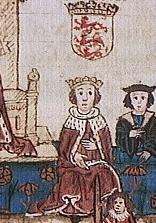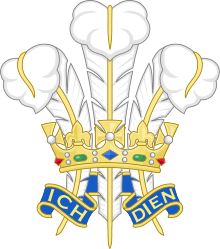Investiture of the Prince of Wales

The Investiture of the Prince of Wales is the ceremony marking the formal creation of the title of Prince of Wales, similar to a coronation. An investiture is not required for the Prince of Wales, as the title is created via letters patent, and consequently the ceremony is for ceremonial purposes only.
History

The tradition of investing the heir-apparent of the English, and subsequently British, monarch with the title of "Prince of Wales" began in 1301, when King Edward I of England, having completed the conquest of Wales, gave the title to his heir-apparent, Prince Edward (later King Edward II of England).
Form
Princes of Wales may be invested, but investiture is not necessary to be created Prince of Wales. Peers were also invested, but investitures for peers ceased in 1621, during a time when peerages were being created so frequently that the investiture ceremony became cumbersome. Most investitures for Princes of Wales were held in front of Parliament, but in 1911, the future King Edward VIII was invested in Caernarfon Castle in Wales. The present Prince of Wales, Charles, was also invested there in 1969.
The ceremony in 1969 began with Prince Charles, led by the regalia bearers, entering the Chamberlain Tower, to await the arrival of Her Majesty. Once the royal family had arrived, the lesser members took their seat in the gallery, but the Queen and Duke of Edinburgh, led by the Earl of Snowdon, the Lord Great Chamberlain, the Earl Marshal and the Gentleman Usher carrying the Great Sword of State, made their way to the stage where the investiture was to be conducted. After reaching the podium where the Secretary of State for Wales, carrying the Letters Patent was already standing, the Earl Marshal instructed Garter to retrieve the Prince and his cortège from the tower. As they came to the stage Prince Charles knelt before the three thrones on the stage. During the reading of the Letters Patent in Welsh, the Queen invested Charles with the girdle, sword, coronet, ring, rod and kingly mantle, in that order. Prince Charles then stated, "I, Charles, do become your liege man of life and limb and of earthly worship, and faith and truth I bear unto you, to live and die against all manner of folks." Charles then customarily kissed the Queen's cheek and they embraced. Charles then took his place in the throne at his mother's right, before standing to give two speeches, one in Welsh and one in English. A brief church service was then conducted and the Queen led the Prince of Wales to Queen Eleanor's Gate, to receive the homage of his adopted nation. The numerous banners and standards of the Prince of Wales were hung from the balcony.
The Letters Patent stated that Charles Phillip Arthur George would receive the title, style, honour and privilege of the Principality of Wales and Earldom of Chester."
Regalia
During the reading of the letters patent creating the Prince, the Honours of the Principality of Wales are delivered to the Prince. The coronet of the heir-apparent bears four crosses pattée alternating with four fleurs-de-lis, surmounted by a single arch (the Sovereign's crowns are of the same design, but use two arches). A gold rod is also used in the insignia; gold rods were formally used in the investitures of dukes, but survive now in the investitures of Princes of Wales only. Also part of the insignia are a ring, a girdle, a sword and a robe.
Coronets

It is recorded that Llywelyn ap Gruffudd had deposited his coronet along with his other regalia with the monks at Cymer Abbey for safekeeping at the start of his final campaign in 1282. He was killed later that year. It was seized and presented to King Edward I of England as a token of the complete annihilation of the independent Welsh state.[1]
Frederick, Prince of Wales, later had the Coronet of Frederick, Prince of Wales, made at a cost of one hundred and forty pounds and five shillings in 1728. It is unknown whether Frederick ever wore the coronet himself but it was used both by his son, George III, and his grandson, George IV, when each was Prince of Wales.
Due to age Frederick's coronet was replaced by the Coronet of George, Prince of Wales, made for the future King George V. At George's own coronation in 1911, the coronet was worn by his son, Edward, the next Prince of Wales.
When the former King Edward VIII went into exile as the Duke of Windsor in 1936 (following his abdication), he took with him the Coronet of George, Prince of Wales, a highly controversial—and illegal—act. This coronet had been specially created for King George V, then Prince of Wales, and he wore it at his father's coronation in 1902. The traditional coronet being unavailable, and with the older Coronet of Frederick, Prince of Wales being viewed unusable due to age, the only option was the creation of a new Prince of Wales crown to be used for the investiture of the current heir apparent to the throne as Prince of Wales. The Coronet of Charles, Prince of Wales, was produced by a committee under Antony Armstrong-Jones, 1st Earl of Snowdon, then husband of Princess Margaret, Countess of Snowdon.
Investiture of Prince Charles
1.jpg)

Prince Charles was created Prince of Wales and Earl of Chester by Letters Patent on 26 July 1958,[2][3] though his actual investiture did not take place until 1 July 1969. The ceremony at Caernarfon was well received by the majority of Welsh people but some nationalists view it as being associated with the subjugation of Welsh people since the 13th century, when Edward I deposed the last native Prince of Wales, Llywelyn ap Gruffudd. Previous investitures had taken place at various locations, including the Palace of Westminster, the seat of Parliament.[4] The Welsh borough of Swansea was granted city status to mark the occasion.[5][6] Taught by Edward Millward,[7] Prince Charles spent ten weeks leading up to his Investiture learning about Welsh culture and language and during the ceremony he gave his replies in both English and Welsh.[8]
The investiture was watched by millions on television, and attracted large and excited crowds in Caernarfon, but it also aroused considerable hostility among a minority of nationalist and republican Welsh people. The nationalist campaign against the investiture culminated with an attempted bombing by two members of the Mudiad Amddiffyn Cymru (Movement for the Defence of Wales). On the eve of the investiture 2 bombers were killed whilst placing a bomb outside government offices in Abergele.[9] In recent years, it has been claimed that the KGB plotted to disrupt the proceedings by bombing a bridge in Porthmadog.[10]
In recent opinion polls the majority of Welsh people have remained in favour of the monarchy with 70% plus support the usual figure;[11] a poll in North Wales in 2003 by the Daily Post found 80% of respondents wanted Prince William to become the next Prince of Wales.[12] Welsh speakers are no less likely to be monarchist, with a BBC Wales poll in 1999 finding that 73% of Welsh speakers want the position of Prince of Wales to continue.[13] A BBC poll to mark the 40th anniversary of the investiture showed that 58% of the Welsh population were in favour of a similar public ceremony for Prince William when Charles becomes king.[14]
On the evening of 28 June 2009—to commemorate the 40th anniversary of the investiture—BBC Parliament broadcast a repeat of the original BBC TV colour outside broadcast from 1 July 1969, fronted by Cliff Michelmore and Richard Baker. This was preceded by an interview with Prince Charles recorded a few days before his investiture.
References
- ↑ "History of Wales".
- ↑ The London Gazette: no. 41460. p. 4733. 29 July 1958. Retrieved 2008-09-02.
- ↑ Princes of Wales's site on previous Princes of Wales
- ↑ "The Royal Family > Royal titles > Style and titles of The Prince of Wales". Retrieved 2008-09-01.
- ↑ "Frequently Asked Questions (FAQs) - When was Swansea given city status?". Retrieved 2008-09-01.
- ↑ The London Gazette: no. 44986. p. 12450. 12 December 1969. Retrieved 2008-09-02.
- ↑ "Charles termed serious, hard-working student", Leader-Post, 24 May 1969, p.1
- ↑ "Investiture as Prince of Wales".
- ↑ "'Militants' key role in coming of devolution left ignored deliberately'".
- ↑ "Prince of Wales 'bomb plot' revealed". BBC News. 13 September 1999. Retrieved 5 May 2010.
- ↑ "Monarchy Wales".
- ↑ "Encyclopedia.com".
- ↑ "Wales backs Charles for king". BBC News. 25 June 1999. Retrieved 5 May 2010.
- ↑ "Poll shows support for monarchy". BBC News. 30 June 2009. Retrieved 5 May 2010.
.svg.png)
